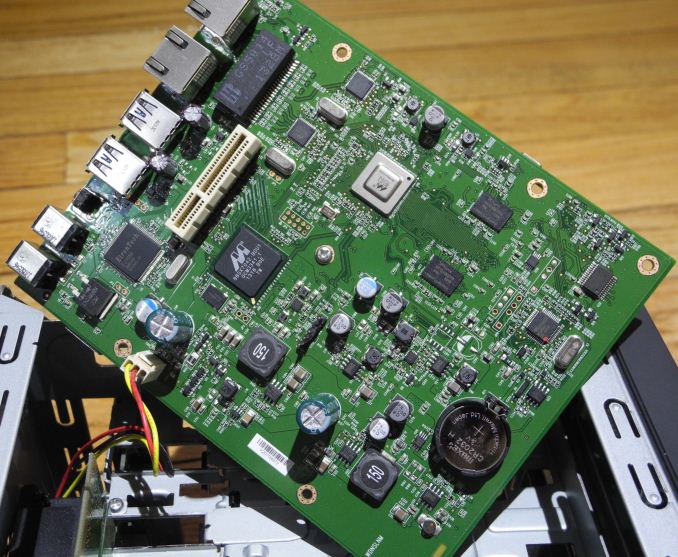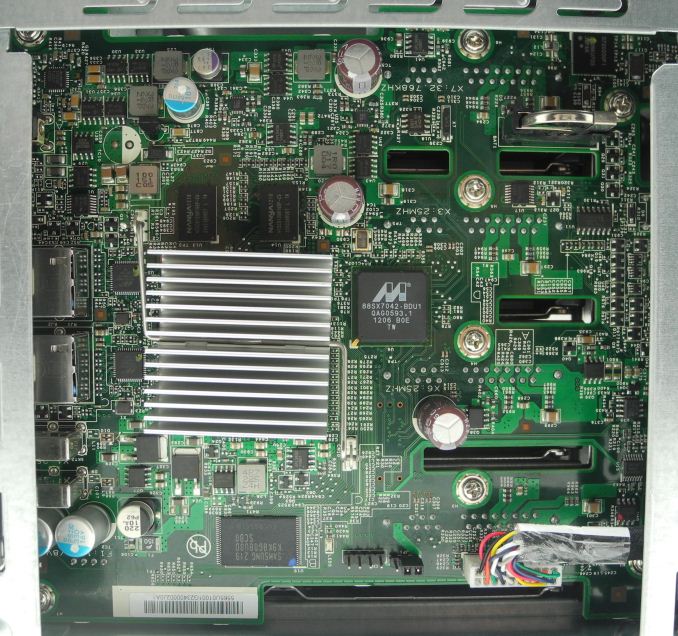Western Digital My Cloud EX4 and LenovoEMC ix4-300d Home NAS Units Review
by Ganesh T S on February 26, 2014 2:30 AM EST- Posted in
- NAS
- Western Digital
- LenovoEMC
Teardown and Platform Analysis
The internal specifications, as well as the available I/O ports, of the LenovoEMC ix4-300d and the Western Digital My Cloud EX4 were tabulated in the previous page. Both the NAS units come with 90W power bricks (100 - 240V AC-in, 19V @ 4.7A DC-out). Despite having two GbE ports, only one RJ-45 cable is supplied in each package. While the EX4 doesn't have any I/O ports in the front, the ix4-300d has a USB 3.0 port beneath the power button. Moving to the rear, the WD EX4 has two power jacks, two USB 3.0 ports, a recessed reset button and two GbE ports at the top. Perforations for a single large fan make up the lower segment. On the other hand, the ix4-300d has two USB 2.0 ports, two GbE ports, a recessed reset button and the DC jack on the left side of the rear face, while a single large fan makes up the right side.
On the i4-300d, the chassis cover has to be removed in order to add or replace hard drives. This is an acceptable solution since the unit doesn't have hot swap capability. The drive caddy is interesting in the sense that the hard drives don't need to be secured with screws. Rather, the caddy has 'screws' which slot into the appropriate drive holes. The caddies have to be pulled out with force, and the whole drive addition / replacement experience, though fast, is not entirely a pleasant one. It would be preferable to have a traditional caddy to support both 2.5" and 3.5" drives. The EX4, on the other hand, completely does away with the caddies. The hard drive slots are sized exactly to fit in a 3.5" drive in the correct orientation. There are no drive caddies or screws to bother with. Despite the Marvell ARMADA XP in the ix4-300d being clocked only at 1.3 GHz and the Kirkwood SoC in the EX4 being clocked at 2.0 GHz, it is the ix4-300d which has a heatsink on top of the SoC. The EX4 just opts for open air cooling.
Western Digital My Cloud EX4 Motherboard
The Marvell 6282 is a well-known entity in NAS circles. We have seen its 1.6 GHz lower-clocked cousin in the Synology DS211+ and the Netgear NV+ v2. As a recap, the SoC configuration of the 6282 is provided below.
Marvell Kirkwood 6282 Block Diagram
The WD EX4 has two GbE ports, and we can see that the 6282 has two native GbE MACs on-board. The other interesting components on the board are the Marvell 88SX7042 (4-port SATA to PCIe x4 bridge), the Etron EJ168A (2-port USB 3.0 to PCIe x1 bridge) and two Marvell 88E1518 GbE transceivers. Even considering the fact that the SATA SERDES lanes on the 6282 were reconfigured for PCIe (unlikely, since there is no reference in the Marvell documentation to that being possible), we are left with an imbalance: A total of five PCIe lanes are needed for the peripherals, while the SoC only provides two. It is simply not possible for the system to support all peripheral I/Os are full speed. What does this have on routine performance? We hope to address this in the performance sections of the review.
Moving on to the ix4-300d, we find it to be based on a dual-core Marvell ARMADA XP dual-core solution, the Marvell MV78230. A block diagram of the high-end ARMADA XP solution is given below.
Marvell ARMADA XP Block Diagram
The main difference between the MV78230 solution and the 78460 represented above are the number of cores (2 instead of 4 v7 CPUs), core frequency (1.3 GHz instead of 1.6 GHz), L2 cache size (1 MB instead of 2 MB), DRAM buswidth (32 instead of 64), number of GbE ports (3 instead of 4) and number of SERDES lanes (7 instead of 16). A photo of the main components of the ix4-300d motherboard is shown below.
LenovoEMC ix4-300d Motherboard
The Marvell 88SX7042 SATA to PCIe bridge again makes an appearance. The four SATA ports connect to the daughterboard and interface with the disks in the drive bays. On the other side, this bridge connects to four SERDES lanes (configured as PCIe) on the MV78230. On the top right of the picture above, a Renesas µPD720200A USB 3.0 to PCIe 2.0 x1 bridge can be seen. It takes up one more SERDES lane. This still leaves a couple of spare SERDES lanes, as the only other I/Os (two USB 2.0 ports and two GbE ports) have direct interfaces on the SoC. On the whole, the platform design of the ix4-300d seems to be able to guarantee exploitation of the full performance from all connected peripherals simultaneously. The performance sections will prove whether the inferences from the board design translate to performance in real-world situations also.


























38 Comments
View All Comments
Navvie - Wednesday, February 26, 2014 - link
I am amazed that a torrent client is included in the Lenovo machine. I wonder how many customers will put that to honest, law abiding use?Although RAID6 has a big impact on capacity when dealing with four drives, I'd really like to see those numbers. I would be disappointed not to see those numbers at 5+ drives.
Beany2013 - Wednesday, February 26, 2014 - link
I've found the torrent client pretty useful on my Syno DS214+ - if I find I need to download an ISO for a VM appliance or distro from work, I can dial into my NAS at home, and tell it to kick off the download while I'm out at work.Yes, you can use it for nefarious purposes, but that's down to the user - I could use a car to mow down some grannies at a bus stop or ram-raid a convenience store, but that doesn't mean we should ban cars.
(my word, that as an atrocious analogy. I shall flagellate myself later as punishment)
Also, nice to see that The Registers quick review a few weeks ago wasn't wrong about the performance of that WD unit, it's bloody pathetic.
ddriver - Wednesday, February 26, 2014 - link
Torrents are not intrinsically illegal.Death666Angel - Wednesday, February 26, 2014 - link
Why would you use RAID6 with 4 disks? Why not just RAID 10? RAID 6 only makes sense to me once you go to 5 and more.DanNeely - Wednesday, February 26, 2014 - link
Possibilities:A) It's provided as a feature check.
B) Leaving it in reduces the number of changes vs a baseline firmware that is also used for larger models.
C) If the enclosure supports a way to add external drives to an array. (doubtful)
I'm guessing a combination of A and B.
Death666Angel - Wednesday, February 26, 2014 - link
1 and 2 only answer the question of "why should they have it" not "why would you use it". :)PEJUman - Wednesday, February 26, 2014 - link
R6 can tolerate 2 any disks failure.R10 can tolerate 1 disk failure, maybe 2 (if both disks from the same stripe failed, you're hosed). I tend to think R10 as a higher performing R1, not a dual disk failure redundancy.
Nonetheless, I agree that the R6 usability on a 4 disks array is quite dubious.
Navvie - Thursday, February 27, 2014 - link
RAID6 would allow any two drives to fail without a loss of data. RAID10 also allows two drive failures, but only if those two drives don't mirror each other. Drives are more likely to fail while reconstructing a failed drive. In a RAID10 setup the failed drive is being rebuilt from data on just one drive, if that drive also fails? Bye bye data.RAID1, RAID10 offers no better reliability than RAID1.
RAID6 has something like 8-10x the reliability of RAID1, and 100x of RAID5.
Adding RAID6 numbers to reviews as this would allow devices with 4 bays and up to be tested consistently - assuming the firmware supported RAID6.
powerwiz - Thursday, February 27, 2014 - link
Generally any NAS comes with a bit-torrent client. Lacies do I know for certain as I have a Lacie NAS. Works well to.Torrents if you do not know were created by University researchers to distribute large amounts of data fast. What you use it for is up to you. Take the internet..the biggest money maker is still porn. You can get a college degree via the internet but it seems worldwide its main use is porn. All up to the user.
vanel86 - Monday, March 3, 2014 - link
The torrent client within lifelines tends to corrupts downloads if the torrent relies on DHT(if it relies on DHT only it won't even start). When i download files out of it (linuxes iso what the hell are you thinking :P) i need to run those files out of utorrent to check if they are fine or not(most cases require a 1% redownload each time)